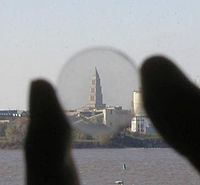
Photo from wikipedia
Optical properties of transparent matrix composites containing metal nanoparticles coated with an oxide shell were numerically simulated based on the Aden-Kerker theory applicable for concentric spheres. Using pentaerythritol tetranitrate composites… Click to show full abstract
Optical properties of transparent matrix composites containing metal nanoparticles coated with an oxide shell were numerically simulated based on the Aden-Kerker theory applicable for concentric spheres. Using pentaerythritol tetranitrate composites (containing Al/Al2O3 nanoparticles) as an example, the linear scattering and absorption coefficients as well as the total reflectance and transmittance and collimated beam transmittance were shown to be determined by the sample thickness, the nanoparticle radius, the mass fraction of nanoparticles, and mass fraction of the oxide in the nanoparticles. An approach to determining the said parameters based on the comparison of the calculated spectral dependencies of the reflectance and transmittance with the experimental ones was suggested. The nanoparticle radius was determined with the minimum error (of about 2 – 3 %), while the nanoparticle mass fraction and oxide mass fraction were weak parameters determined with a 25 % error.
Journal Title: Computer Optics
Year Published: 2018
Link to full text (if available)
Share on Social Media: Sign Up to like & get
recommendations!